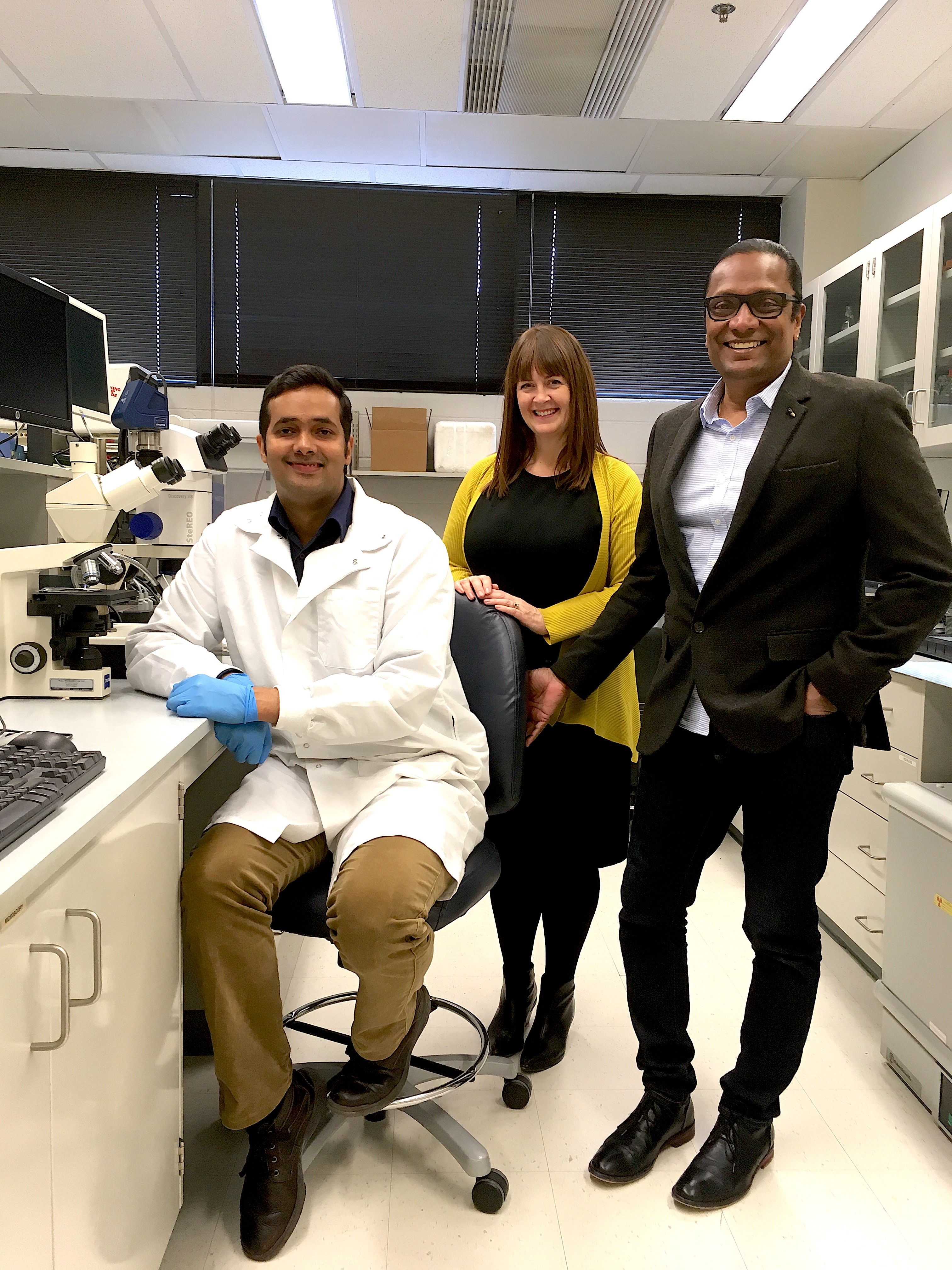Scientists working at the C.S. Mott Center for Growth and Development, Wayne State University School of Medicine’s Department of Obstetrics and Gynecology, have discovered a way to control estrogen receptor changes in pregnancy, possibly leading to a therapy that could prevent preterm birth – the most significant cause of infant morbidity and mortality in the United States.

“To understand why preterm birth occurs, we need to discover the mechanisms that govern the onset of normal term labor, which unfortunately, despite decades of research, we still do not understand,” said Assistant Professor of Obstetrics and Gynecology Jeyasuria Pancharatnam, Ph.D.
Estrogen, a steroid hormone, is thought to signal the onset of labor by playing a critical role in regulating the contraction of uterine muscles.
Dr. Jeyasuria’s research team discovered that the uterine muscle changes the ability of the estrogen receptor to use the steroid hormone estrogen to induce contraction by changing the form of the estrogen receptor. The form expressed in the pregnant uterus across gestation is an estrogen receptor that blocks the ability of the uterine cell to contract during pregnancy.
“However, at term, a dramatic shift occurs in which the form of the estrogen receptor changes to one that permits contractions, allowing for the onset of labor. We have demonstrated in our cell culture model that we can change the forms of the estrogen receptor from a non-contractile to a contractile form and believe that this phenomenon may be used as a therapeutic for the prevention of preterm birth,” Dr. Jeyasuria said.
He and wife Jennifer Condon, Ph.D., an associate professor and study co-investigator, run their lab in the C.S. Mott Center for Human Growth and Development. Both are members of the Perinatal Research Initiative, funded through the National Institutes of Health’s Eunice Kennedy Shriver National Institute of Child Health and Human Development’s Perinatal Research Branch at Wayne State University.
Postdoctoral fellow Prashanth Anamthathmakula, Ph.D., is “a fantastic addition to our lab and has been technically superb, while also helping with intellectual input into this project.”
He is also grateful to staff and faculty of the Perinatalogy Research Branch, especially Professor of Obstetrics and Gynecology and Associate Vice President of Women’s Health Sonia Hassan, M.D. ’94, who recruited him from the University of Pittsburgh.
“Dr. Hassan has been very supportive of the work and has supplied myometrial tissue and other reagents to make this project possible,” he said.
Despite increasing knowledge of the pathological mechanisms associated with preterm labor and subsequent birth, the rates of preterm birth continue to increase, with more than 9.6 percent of all births in 2015 occurring before 37 weeks gestation. The rate of preterm birth in Detroit is the highest of cities in the U.S. at 14.5 percent according to data compiled by the March of Dimes.
“Our lab has concentrated our efforts on estrogen signaling, as it is important to the onset of the labor process and plays a critical role in the expression of proteins that enhance contractions, termed contractile associated proteins, or CAPS,” Dr. Jeyasuria added.
CAPs are expressed late in gestation, bringing the uterus from an inactive to an active state.
He is the principal investigator on the study “Estrogen Receptor Alpha Isoform ERdelta7 In Myometrium Modulates Uterine Quiescence During Pregnancy,” published in the Lancet journal EBiomedicine.
Future studies will use an animal model system to determine if they can modulate the form of the uterine estrogen receptor available to confirm the functional relevance of the switch in uterine muscle cell estrogen receptor forms.
“Estrogen, like all steroids, depends upon a specific receptor protein in the uterine muscle cell to convey this contractile signal. However, estrogen levels are constantly elevated throughout pregnancy, therefore we hypothesize that changes in the uterine estrogen receptor that occur at the end of pregnancy allow for increased uterine contractions and labor at term,” he said. “To date, there is poor understanding of how CAP protein expression is achieved and the importance of the estrogen receptor in this process. Estrogen is a messenger and functions by binding to its receptor, the estrogen receptor, in the cell. Since estrogen levels are constantly elevated throughout gestation in all mammals and cannot be the intermediary signal, we hypothesized that myometrial contractions at term are mediated by estrogen receptor alpha (ERα) isoform changes,” he said.
Isoforms are different proteins made from the same gene by rearrangements of the message that comes from DNA itself. Messenger RNA can be put together differently depending on another set of proteins called splice proteins.
“As their name suggests, these splice proteins can differentially splice the intermediate RNA (heteronuclear RNA) to create alternate spliced isoforms. We found that some of these alternate isoforms actually block estrogen signaling. This receptor is meant to enhance the signal, but the structure of one of the alternatively spliced variants blocks the signal, termed a dominant negative function. This is the novel finding in our recent paper in Ebiomedicine. We further went on to study the actual splice factors involved and have narrowed it down to one splice factor known as hnRNPG. Therapeutic possibilities involved affecting the areas bound by this splice factor of the heteronuclear RNA message,” he said.
The team has submitted grants to the NICHD to explore the functions of a number of alternatively spliced estrogen receptor isoforms in pregnancy, using animal and human models.
“In the mouse models, we intend to try therapeutic approaches to dampen the effects of chemically induced preterm birth. Our approach will incorporate the use of nanoparticles that carry PNAs that can change the outcome of alternative splicing. This approach can in the future be carried from bench to bedside and used to prevent preterm birth in susceptible women,” he said.
Mutations affecting the multiple promoter regions of the ERα gene (ESR1), which regulate expression of ERα isoforms, may serve as useful markers of preterm birth. The study aims to fill a long-standing gap in the understanding of ER function in the pregnant uterus and in the control of labor during pregnancy.